مناندر الأول
| مناندر الأول Menander I | |
|---|---|
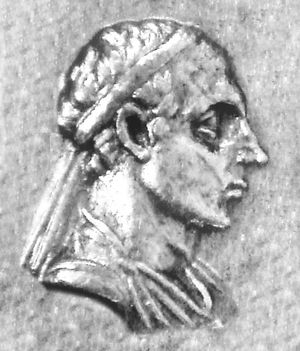 Portrait of Menander I | |
| ملك هندو-يوناني | |
| العهد | 165/155–130 BC |
| سبقه | أنتيماخوس الثاني |
| تبعه | Strato I |
| وُلِد | Kalasi, إسكندرية القوقاز (present day باگرام، أفغانستان)[1][2] |
| توفي | 130 ق.م. |
| المدفن | ستوپات في أرجاء المملكة الهندو-يونانية |
| العقيلة | Agathokleia |
| الأنجال | Strato I |
| البيت | House of Euthydemus |
| الديانة | البوذية |
مناندر الأول المخلص (Menander I Soter ؛ باليونانية قديمة: Μένανδρος Α΄ ὁ Σωτήρ, Ménandros A' ho Sōtḗr, "Menander I the Saviour"; known in Indian Pali sources as Milinda) was an Indo-Greek King of the Indo-Greek Kingdom (165/[3]/155[3] –130 BC) who administered a large empire in the Northwestern regions of South Asia from his capital at Sagala. Menander is noted for having become a patron of Buddhism.
Menander was initially a king of Bactria. After conquering the Punjab[2] he established an empire in South Asia stretching from the Kabul River valley in the west to the Ravi River in the east, and from the Swat River valley in the north to Arachosia (the Helmand Province). Ancient Indian writers indicate that he launched expeditions southward into Rajasthan and as far east down the Ganges River Valley as Pataliputra (Patna), and the Greek geographer Strabo wrote that he "conquered more tribes than Alexander the Great."
Large numbers of Menander’s coins have been unearthed, attesting to both the flourishing commerce and duration of his realm. Menander was also a patron of Buddhism, and his conversations with the Buddhist sage Nagasena are recorded in the important Buddhist work, the Milinda Panha ("The Questions of King Milinda"; panha meaning "question" in Pali). After his death in 130 BC, he was succeeded by his wife Agathokleia who ruled as regent for his son Strato I. Buddhist tradition relates that he handed over his kingdom to his son and retired from the world, but Plutarch relates that he died in camp while on a military campaign, and that his remains were divided equally between the cities to be enshrined in monuments, probably stupas, across his realm.
الحاكم الهندو-يوناني
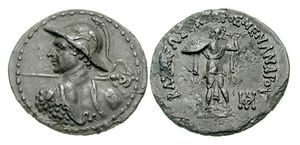
Obv: مناندر يرمي رمحاً.
Rev: أثينا ممسكة بصاعقة. الكتابة اليونانية: ΒΑΣΙΛΕΩΣ ΣΩΤΗΡΟΣ ΜΕΝΑΝΔΡΟΥ (BASILEOS SOTEROS MENANDROU), "للملك مناندر، المخلّص".

وجه العملة: الكتابة اليونانية، ΒΑΣΙΛΕΩΣ ΣΩΤΗΡΟΣ ΜΕΝΑΝΔΡΟΥ (باسيليوس سوتروس مناندرو) الترجمة: "للملك المخلّص مناندر".
الظَهْر: الكتابة الخروشتي: MAHARAJASA TRATARASA MENAMDRASA "الملك المخلص مناندر". أثينا تتقدم على اليمين، ممسكة بصاعقة ودرع. علامة صك تكسيلا.


Greek legend: ΒΑΣΙΛΕΩΣ ΣΩΤΗΡΟΣ ΜΕΝΑΝΔΡΟΥ
(BASILEOS SOTEROS MENANDROU)
حرفياً "للملك المخلّص مناندر". المتحف البريطاني.
كما يقترح اسطرابون أن تلك الفتوحات اليونانية امتدت حتى العاصمة پاتاليپوترا في شمال شرق الهند، اليوم پاتنا):
أولئك الذين جاؤوا بعد أن ذهب الإسكندر إلى الگنج وپاتاليپوترا
— اسطرابون، 15.698
مناندر والبوذية
ملندا پانها

According to tradition, Menander embraced the Buddhist faith, as described in the Milinda Panha, a classical Pali Buddhist text on the discussions between Milinda and the Buddhist sage Nāgasena. He is described as constantly accompanied by a guard of 500 Greek ("Yonaka") soldiers, and two of his counsellors are named Demetrius and Antiochus.
وهناك قانون بوذي مكتوب باللغة الباليّة، تراه يضم المتناقضات، شأنه في ذلك شأن أي كتاب مقدس يحمي مصالح الكهنوت، وفي هذا القانون رسالة تستوقف النظر لعلها قديمة قدم المسيحية، وتسمى "أسئلة الملك مِلِنْدا" وفيها المعلم البوذي "نجاسينا" يجيب إجابات جد مثيرة للأسئلة الدينية التي يوجهها إليه "الملك مناندر" الإغريقي الباكتريّ الذي حكم شمالي الهند في مستهل القرن الأول قبل المسيح؛ يقول "نجاسينا" إن الدين لا ينبغي أن يتخذ مجرد وسيلة فرار يلوذ بها المعذبون ، بل يجب أن يكون سعي الزاهد حتى يبلغ مرحلة القداسة والحكمة دون أن يزعم وجود جنة أو إله، لأن هذا القديس يؤكد لنا أنه لا وجود لجنة أو إله(77).
From Alasanda the city of the Yonas came the thera ("elder") Yona Mahadhammarakkhita with thirty thousand bhikkhus.
المنشآت البوذية

مناندر الثاني، حاكم بوذي آخر

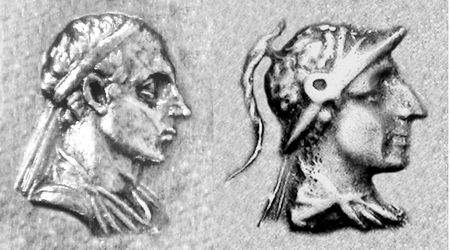
وفاة مناندر
Plutarch reports that Menander died in camp while on campaign, thereby differing with the version of the Milindapanha. Plutarch gives Menander as an example of benevolent rule, contrasting him with disliked tyrants such as Dionysius, and goes on explaining that his subject towns disputed about the honour of his burial, ultimately sharing his ashes among them and placing them in "monuments" (possibly stupas), in a manner reminiscent of the funerals of the Buddha.[6]
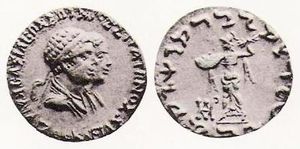
Obv: Conjugate busts of Strato and Agathokleia. Greek legend: BASILEOS SOTEROS STRATONOS KAI AGATOKLEIAS "Of King Strato the Saviour and Agathokleia".
Rev: Athena throwing thunderbolt. Kharoshthi legend: MAHARAJASA TRATASARA DHARMIKASA STRATASA "King Strato, Saviour and Just (="of the Dharma")".
ذكراه
البوذية

تمثيل البوذا
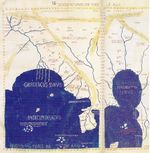
الجغرافيا
In Classical Antiquity, from at least the 1st century, the "Menander Mons", or "Mountains of Menander", came to designate the mountain chain at the extreme east of the Indian subcontinent, today's Naga Hills and Arakan, as indicated in the Ptolemy world map of the 1st century geographer Ptolemy.[7]
انظر أيضاً
الهامش
- ^ "Menander". Encyclopædia Britannica Online. Encyclopædia Britannica, Inc. Retrieved 8 September 2012.
- ^ أ ب خطأ استشهاد: وسم
<ref>غير صحيح؛ لا نص تم توفيره للمراجع المسماةHazel 2013 - ^ أ ب Bopearachchi (1998) and (1991), respectively. The first date is estimated by Osmund Bopearachchi and R. C. Senior, the other Boperachchi
- ^ The coins of the Greek and Scythic kings of Bactria and India in the British Museum, p.50 and Pl. XII-7 [1]
- ^ Chapter XXIX of the Mahavamsa: Text
- ^ A passage in the "Mahā-parinibbâna sutta" of the "Dighanikaya" relates the dispute of Indian kings over the ashes of the Buddha, which they finally shared between themselves and enshrined in a series of stupas.
- ^ Boot, Hooves and Wheels: And the Social Dynamics behind South Asian Warfare, Saikat K Bose, Vij Books India Pvt Ltd, 2015 p.222
المراجع
- Monnaies Gréco-Bactriennes et Indo-Grecques, Catalogue Raisonné, Osmund Bopearachchi, 1991, Bibliothèque Nationale de France, ISBN 2-7177-1825-7.
- The Shape of Ancient Thought. Comparative studies in Greek and Indian Philosophies by Thomas McEvilley (Allworth Press and the School of Visual Arts, 2002) ISBN 1-58115-203-5
- Buddhism in Central Asia by B.N. Puri (Motilal Banarsidass Pub, January 1, 2000) ISBN 81-208-0372-8
- The Greeks in Bactria and India, W. W. Tarn, Cambridge University Press.
- Dictionary of Buddhism, Damien Keown, Oxford University Press ISBN 0-19-860560-9
- De l'Indus à l'Oxus, Archéologie de l'Asie Centrale, Osmund Bopearachchi, Christine Sachs, ISBN 2-9516679-2-2
- The Diffusion of Classical Art in Antiquity by John Boardman (Princeton University Press, 1994) ISBN 0-691-03680-2
- The Crossroads of Asia. Transformation in Image and symbol, 1992, ISBN 0-9518399-1-8
- Indo-Greek, Indo-Scythian and Indo-Parthian coins in the Smithsonian institution, Smithsonian Institution, Bopearachchi, 1993
وصلات خارجية
- Coins of King Menander
- More coins of Menander
- Kapisa coinage of Menander
- The Debate of King Milinda
- The Questions of King Milinda
- Catalogue of the coins of Menander
| سبقه دمتريوس الثاني من الهند |
Indo-Greek ruler (Paropamisadae, Arachosia, Gandhara, Punjab) 155/150–130 BC |
تبعه (In Paropamisadae, Arachosia:) Zoilos I (In Gandhara, Punjab:) Agathokleia |




